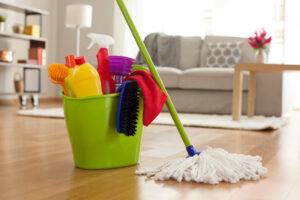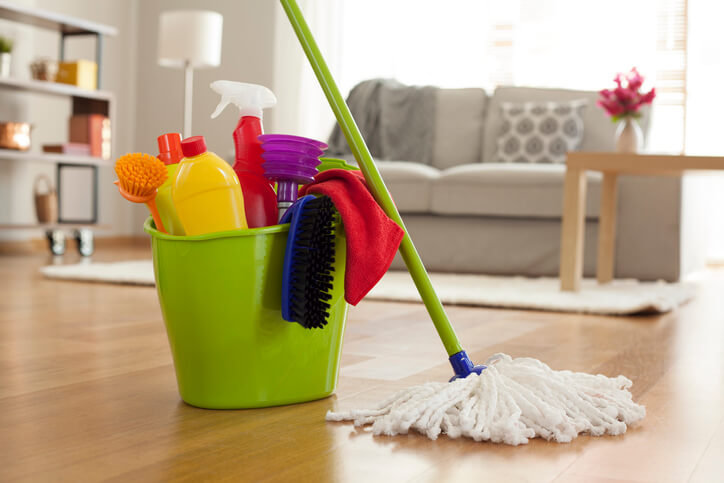Keeping your tiled surfaces looking pristine can be a challenge, especially when it comes to cleaning grout. This porous material tends to absorb liquids, dirt, and debris, leading to unsightly discoloration and staining over time1. Areas with high foot traffic, such as kitchens and bathrooms, are particularly vulnerable due to constant exposure to moisture and spills1. In this guide, we will explore essential grout cleaning tips, effective methods for restoring grout to its former glory, and the type of supplies that can aid in the cleaning process, such as baking soda and white vinegar1. Whether you choose to tackle the task yourself or hire professional services, understanding the importance of clean grout is vital for maintaining a healthy and attractive home environment.

Understanding Grout and Its Importance
Grout is a porous material commonly used in homes to fill spaces between tiles, including those found in kitchens, showers, and floors. Its primary function is to enhance aesthetics and provide structural support. There are four main types of grout: cement-based grout, epoxy grout, furan grout, and ready-to-use grout2. Each type has its specific applications; for example, sanded grout is ideal for wide joints, while unsanded grout works best in narrower ones2.
Clean grout plays a significant role in the maintenance of tiled areas. It helps preserve the fresh look of surfaces by preventing dirt, mold, and bacteria buildup, which can compromise health and hygiene3. Regular cleaning contributes to the longevity of grout, thus enhancing its benefits. Professional tile and grout cleaning can remove harmful contaminants, ensuring that floors remain presentable for many years3. Moreover, maintaining clean grout minimizes health risks by killing harmful germs3.
Maintaining grout requires awareness of its properties and the necessity for periodic cleaning. Cement-based grouts are porous, needing sealing to prevent staining and mold growth2. Regular upkeep not only improves the overall appearance of tiled surfaces but can also save money in the long run by extending the lifespan of the floor3. Understanding the types of grout and benefits of clean grout can lead to better grout maintenance practices that ensure beautiful and safe environments.
Common Grout Problems
Grout frequently faces a variety of problems that can lead to grout discoloration and unsightly stains on grout surfaces. Over time, factors like moisture, improper installation, and continuous wear can severely damage grout, making it vulnerable to various grout issues. For instance, mold growth in bathroom grout lines is particularly common due to elevated moisture levels, which creates a breeding ground for bacteria and unsightly stains4. The presence of water behind tiles can manifest in loose or hollow tiles, indicating a failure in grout integrity that may eventually require professional attention5.
Moreover, the porous nature of grout makes it especially susceptible to permanent stains5. This issue is often exacerbated by incorrect cleaning methods that push dirt deeper into the grout instead of removing it5. Missing or worn grout can lead to further degradation if not addressed quickly, allowing for potential water seepage and additional damage4. In some cases, using a mold-and-mildew-stain-removing cleaner can effectively combat mold in grout lines, restoring them to their original appearance4.
Understanding these common grout problems empowers homeowners to take timely action to prevent long-term damage and maintain clean and functional spaces. Recognizing signs of grout discoloration and stains on grout can facilitate early intervention, whether through cleaning methods or consulting with professionals for necessary repairs6.
Tools and Supplies for Cleaning Grout
Before starting the grout cleaning process, having the right grout cleaning tools and essential supplies for grout cleaning is vital. Common items include a stiff-bristle brush or a dedicated grout brush, a bucket, sponge, and various cleaning solutions. Most grout-cleaning tools are fairly inexpensive, making them accessible for consumers looking to tackle grout cleaning on their own7. For those preferring a more natural approach, DIY grout cleaners can easily be crafted from household products such as vinegar and water, baking soda mixed with liquid detergent, or just baking soda and water7.
Commercial cleaning equipment options include specialty tools like the TurboForce TH40 Turbo Hybrid Tile and Grout Spinner, which boasts a cleaning capacity of 400 to 1,000 square feet per hour depending on surface textures8. The Saiger’s Tsunami Powdered Tile and Grout Cleaner is another excellent choice, designed for superior performance on tile, grout, stone, and concrete surfaces8. When using any cleaning products, it is essential to spot test to ensure there is no damage to the grout or tile7.
Steam cleaners are particularly effective for brightening grout lines, especially for renters who seek to maintain their deposit7. For the best results, it’s important to follow manufacturer instructions to prevent any issues. Gentle scrubbing with a grout-cleaning brush or a handheld tool is recommended after applying a cleaner, contributing to successful grime removal9.
In situations where DIY methods fall short, consider transitioning to professional-grade cleaning equipment or services. A proactive cleaning regimen, such as weekly maintenance with rubbing alcohol, can help prevent the buildup of dirt, mold, and mildew on grout surfaces9.
DIY Grout Cleaning Methods
DIY grout cleaning methods provide a cost-effective way to maintain clean grout lines in your home. With simple ingredients like baking soda, hydrogen peroxide, and mild dish soap, you can create a powerful DIY grout cleaner. A cleaning paste can be made using 3/4 cup baking soda, 1/4 cup hydrogen peroxide, and 1 tablespoon of mild dish soap, achieving a consistency similar to soft toothpaste that won’t drip off your brush9.Learn more about effective grout cleaning.
When using homemade grout solutions, it’s crucial to avoid acidic cleaners, as they can dissolve or pit the grout. For homeowners who have white grout, while chlorine bleach is sometimes used, oxygen bleach is a safer option for preserving colored grout9. Regular cleaning can prevent the buildup of dirt, mold, or mildew, and utilizing rubbing alcohol weekly can help eliminate these spores and maintain cleanliness10.
Recommended tools for effective grout cleaning include a toothbrush, a grout cleaning brush, or even an electrical scrub brush for tougher jobs. Steam cleaning is another option that provides a chemical-free method, rated well for deep and light routine cleaning11. After steam cleaning, applying grout sealer protects the surfaces and prevents future stains.
Before using any DIY grout solution, test it on a small area first to ensure it won’t cause unwanted damage. Remember that homemade solutions should be used promptly as hydrogen peroxide loses its effectiveness when exposed to light for extended periods10.
Professional Grout Cleaning Services
When faced with stubborn grout stains or extensive dirt buildup, professional grout cleaning services prove invaluable. Companies like ServiceMaster Clean, with over 75 years of expertise, offer tailored plans for various flooring types, including ceramic and travertine, ensuring each facility receives a high standard of clean12. Utilizing industrial-strength products and specialized equipment, these professionals effectively remove oils and grease that naturally accumulate in grout, preserving its appearance and longevity13.
The benefits of hiring professionals extend beyond appearance; they provide deep cleaning that significantly differs from typical home methods. For instance, Chem-Dry technicians utilize various cleaning solutions matched to specific stone types, such as marble and limestone, ensuring that the cleaning process does not damage sensitive surfaces14. Their expertise means they can perform additional services, like grout color restoration and stone polishing, enhancing the overall aesthetic of tiled areas in homes or businesses.
Beyond residential services, commercial grout cleaning is a growing market. High-traffic areas like kitchens and showers require more frequent care, making it essential for businesses to invest in professional services that guarantee pristine results14. With more than 198,536 certified customer reviews for services like those provided by Sears, it’s clear that the demand for professional cleaning is robust, showcasing trust in these comprehensive solutions13.
In conclusion, professional grout cleaning not only improves the look of tiled surfaces but also contributes to a healthier environment and potentially extends the lifespan of grout. Understanding the numerous advantages of hiring professionals enables homeowners and business owners alike to maintain their spaces effectively and efficiently.
Preventing Grout Discoloration
Preventing grout discoloration is essential for maintaining its pristine appearance. One of the primary causes of grout discoloration includes dirt and grime accumulation or using harsh cleaning products15. Regular cleaning, ideally at least once a week, helps to remove surface dirt and stains before they can penetrate15. Implementing preventative measures for grout can significantly enhance its lifespan.
Understanding the factors contributing to discoloration is vital. Mould and mildew growth is a major factor in humid environments, often leading to unsightly stains16. Using mild, pH-neutral cleaners specifically designed for tile and grout is essential to avoid damage and maintain color integrity15.Promoting regular cleaning routines can prevent dirt build-up which ultimately results in discoloration.
Applying a quality grout sealer after installation or following a thorough cleaning can provide a protective barrier against moisture and stains15. It is advisable to reseal grout annually, especially in high-traffic areas, to maintain its cleanliness and prevent deep staining15. Proper ventilation in areas prone to moisture, such as bathrooms, also helps deter mould growth, thereby preventing stains16.
Taking immediate action on spills and stains can prevent liquids from penetrating grout lines16. Gentle cleaning tools, such as soft brushes and cloths, ensure that the grout surface remains undamaged during maintenance routines16. Regular inspections for discoloration can help identify and address any issues promptly, promoting long-lasting cleanliness and aesthetics.

Best Practices for Maintaining Clean Grout
Keeping grout clean requires consistent effort. Simple actions like promptly cleaning spills minimize premature staining and damage. Proper daily maintenance, such as wiping and spraying after every bath or shower, can effectively prevent issues related to grout accumulation17. Using mats at entrances can significantly reduce the dirt traffic that often leads to grout discoloration18.
Regular cleaning is essential. Weekly deep cleaning helps tackle body oils and soap scum that naturally buildup, even with daily care17. A paste made of water and baking soda serves as an effective weekly solution to mitigate stains and maintain grout integrity17. Avoid abrasive cleaners, as they may damage the porous nature of grout, stripping away its protective seal18. For heavily stained grout, bleach pens or oxygen-based powdered bleach can be considered for effective removal17.
Applying a grout sealer provides an extra layer of protection against future staining, extending the life of your grout17. Being vigilant for signs of wear, like flaking or breaking grout, is critical. If grout needs replacement, professional help is advisable, especially if DIY skills are lacking. Changing tiles may also create a refreshed look while enhancing your space17.
For more detailed grout maintenance tips, check out this useful resource on cleaning grout effectively.
Eco-Friendly Grout Cleaning Solutions
For homeowners looking to prioritize their health and the environment, eco-friendly cleaning products are an excellent option for grout cleaning. Utilizing natural ingredients like vinegar, baking soda, and essential oils, these sustainable cleaning methods effectively combat stubborn stains without introducing harsh chemicals into your home. This approach is particularly beneficial for families with children and pets, ensuring a safer living space while achieving impressive cleaning results.
For a more targeted cleaning experience, products like the Black Diamond Ultimate Grout Cleaner come in a 64-ounce bottle size, making it a practical choice for extensive grout areas19. Similarly, Mrs. Meyer’s Clean Day Tub and Tile Cleaner, available in a 33-ounce bottle, leverages eco-friendly formulations to achieve powerful cleaning with minimized environmental impact19. These eco-friendly cleaners often showcase responsible packaging that aligns with sustainable cleaning methods, emphasizing a holistic approach to home care.
Investing in green grout cleaning products like the Better Life Bathroom Cleaner, which comes in a 32-ounce bottle, and retails for a competitive price, further supports a green lifestyle19. Consumers can feel confident that using such products does not compromise performance for sustainability, and they can conveniently reduce their reliance on disposable wipes by utilizing microfiber cloths that trap dirt effectively20. Moreover, environmentally friendly sealants are available that are water-based and low in volatile organic compounds (VOCs), providing robust protection for your tiles and grout without environmental harm20.
Making the switch to eco-friendly grout cleaning solutions can lead to a cleaner home and a healthier planet, promoting sustainable practices that benefit everyone1920.
Troubleshooting Stubborn Grout Stains
Removing difficult grout stains can be quite the challenge, but with the right approach, it becomes manageable. Start by considering an oxygen bleach solution, which is effective for cleaning grimy white grout stains and ideal for small areas like showers or kitchen backsplashes21. A DIY paste made from baking soda, dish detergent, and hydrogen peroxide often yields impressive results for tough stains22. These advanced grout cleaning techniques can help restore your surfaces without the need for harsh chemicals.
For deeper cleaning, a steam cleaner can be particularly useful. It received a rating of 3 out of 5 for deep cleaning capabilities, providing effective steam penetration into stubborn stains23. When using tools like this, regular maintenance evolves into a mechanism for preventing stains from becoming persistent issues.
Regarding tips for stubborn stains, it’s important to approach the cleaning process systematically. Start with the mildest cleaning solutions and escalate to stronger ones only if necessary. The Pink Stuff is an affordable option at $5 and has been highlighted for its quick effectiveness in removing dirt and stains23. Ensure you have a grout sealant ready for application afterward to protect your grout lines from future discoloration and water damage22.
Finally, remember to evaluate the type of grout in your space. Traditional cement grout and epoxy grout have their own strengths, affecting how stains should be tackled21. Keep experimenting with different techniques until you find what works best for your specific needs.
Final Thoughts on Cleaning Grout
In summary, maintaining grout cleanliness is essential for both aesthetic and health reasons. Dirty grout can harbor harmful bacteria such as streptococcus, staphylococcus, salmonella, and E. coli, especially in frequently used areas like kitchens and bathrooms24. Therefore, a regular grout cleaning routine is crucial, with recommendations suggesting cleanings weekly to bi-weekly in high-use areas and at least annual professional services24. This proactive approach not only enhances the beauty of your home but also contributes to a healthier living environment.
Utilizing various grout cleaning methods, whether DIY or professional, can lead to significantly improved appearances of grout lines. Products like the Tuff Duck sealant and Miracle Sealants can effectively prolong the freshness of your grout, while solutions like vinegar and baking soda are great for tackling tough stains24. However, remember that the process can be labor-intensive, and safety must be a priority — it’s advised to avoid harsh bleach or ammonia-based cleaners that can cause damage24.
Ultimately, the knowledge gathered from this guide empowers homeowners to take action. By implementing a consistent cleaning schedule and utilizing appropriate products like Polyblend Grout Renew, the benefits of clean grout will last for years, enhancing the overall appeal of your home25. Embrace the importance of clean grout and enjoy a tidy, attractive space consistently.
FAQ
Q: What is grout, and why is it important?
A: Grout is a porous material used to fill the spaces between tiles, enhancing aesthetics while providing structural support. Maintaining clean grout is essential as it prevents the build-up of dirt, mold, and bacteria, thereby ensuring health and hygiene in tiled areas.
Q: What are some common issues with grout?
A: Common grout problems include discoloration, stubborn stains, and the accumulation of dirt due to spills or mold growth. Over time, these issues can cause the grout to appear dull or darkened.
Q: What tools do I need for cleaning grout?
A: Essential tools for cleaning grout include a stiff-bristle brush or a dedicated grout brush, a bucket, sponge, and various cleaning solutions. Homemade alternatives like baking soda and hydrogen peroxide can also be effective.
Q: How can I clean grout at home?
A: You can create DIY grout cleaners using simple ingredients such as baking soda and hydrogen peroxide. Common methods involve applying a paste, soaking, and scrubbing the grout lines.
Q: When should I consider hiring professional grout cleaners?
A: Hiring professionals may be necessary for treating stubborn stains or extensive dirt. They use specialized equipment and industrial-strength products that ensure thorough cleaning without causing damage to the grout.
Q: How can I prevent grout discoloration?
A: Regular maintenance such as weekly cleaning with rubbing alcohol and deep cleaning can help prolong grout’s appearance. Being aware of common staining agents and taking preventative measures can also be beneficial.
Q: What are some best practices for maintaining clean grout?
A: Best practices include routine cleaning, promptly cleaning spills, using mats to reduce dirt traffic, and regularly applying a grout sealer. These actions help maintain grout’s integrity and appearance over time.
Q: Are there eco-friendly options for cleaning grout?
A: Yes, eco-friendly cleaning methods using natural ingredients like vinegar, baking soda, and essential oils are effective. These solutions are safer for households with children and pets while still delivering impressive results.
Q: What should I do if I have stubborn grout stains?
A: For stubborn stains, you might try using an oxygen bleach solution, making a paste from baking soda and hydrogen peroxide, or experimenting with steam cleaning techniques to reach deep-set stains.



